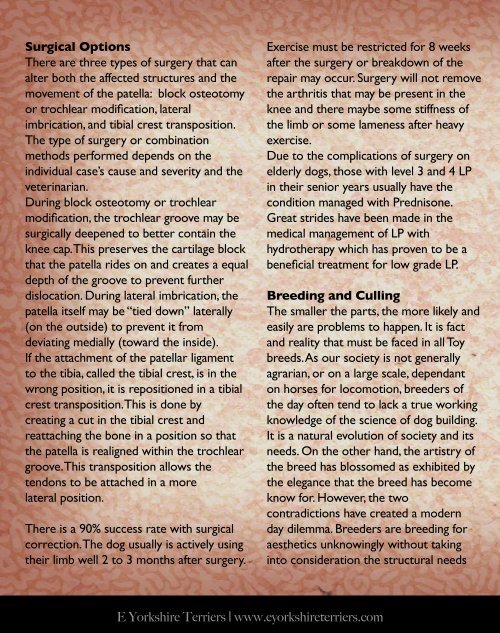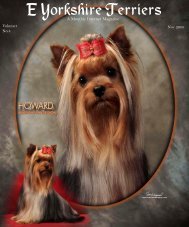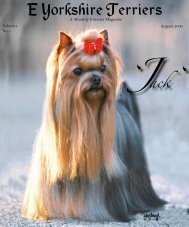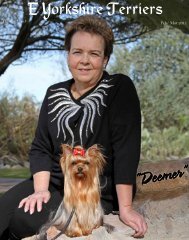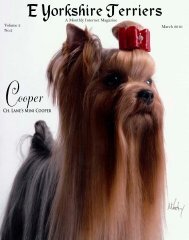Download Complete Oct/ Nov Edition in PDF Format - E Yorkshire ...
Download Complete Oct/ Nov Edition in PDF Format - E Yorkshire ...
Download Complete Oct/ Nov Edition in PDF Format - E Yorkshire ...
You also want an ePaper? Increase the reach of your titles
YUMPU automatically turns print PDFs into web optimized ePapers that Google loves.
Surgical Options<br />
There are three types of surgery that can<br />
alter both the affected structures and the<br />
movement of the patella: block osteotomy<br />
or trochlear modification, lateral<br />
imbrication, and tibial crest transposition.<br />
The type of surgery or comb<strong>in</strong>ation<br />
methods performed depends on the<br />
<strong>in</strong>dividual case’s cause and severity and the<br />
veter<strong>in</strong>arian.<br />
Dur<strong>in</strong>g block osteotomy or trochlear<br />
modification, the trochlear groove may be<br />
surgically deepened to better conta<strong>in</strong> the<br />
knee cap. This preserves the cartilage block<br />
that the patella rides on and creates a equal<br />
depth of the groove to prevent further<br />
dislocation. Dur<strong>in</strong>g lateral imbrication, the<br />
patella itself may be “tied down” laterally<br />
(on the outside) to prevent it from<br />
deviat<strong>in</strong>g medially (toward the <strong>in</strong>side).<br />
If the attachment of the patellar ligament<br />
to the tibia, called the tibial crest, is <strong>in</strong> the<br />
wrong position, it is repositioned <strong>in</strong> a tibial<br />
crest transposition. This is done by<br />
creat<strong>in</strong>g a cut <strong>in</strong> the tibial crest and<br />
reattach<strong>in</strong>g the bone <strong>in</strong> a position so that<br />
the patella is realigned with<strong>in</strong> the trochlear<br />
groove. This transposition allows the<br />
tendons to be attached <strong>in</strong> a more<br />
lateral position.<br />
There is a 90% success rate with surgical<br />
correction. The dog usually is actively us<strong>in</strong>g<br />
their limb well 2 to 3 months after surgery.<br />
Exercise must be restricted for 8 weeks<br />
after the surgery or breakdown of the<br />
repair may occur. Surgery will not remove<br />
the arthritis that may be present <strong>in</strong> the<br />
knee and there maybe some stiffness of<br />
the limb or some lameness after heavy<br />
exercise.<br />
Due to the complications of surgery on<br />
elderly dogs, those with level 3 and 4 LP<br />
<strong>in</strong> their senior years usually have the<br />
condition managed with Prednisone.<br />
Great strides have been made <strong>in</strong> the<br />
medical management of LP with<br />
hydrotherapy which has proven to be a<br />
beneficial treatment for low grade LP.<br />
Breed<strong>in</strong>g and Cull<strong>in</strong>g<br />
The smaller the parts, the more likely and<br />
easily are problems to happen. It is fact<br />
and reality that must be faced <strong>in</strong> all Toy<br />
breeds. As our society is not generally<br />
agrarian, or on a large scale, dependant<br />
on horses for locomotion, breeders of<br />
the day often tend to lack a true work<strong>in</strong>g<br />
knowledge of the science of dog build<strong>in</strong>g.<br />
It is a natural evolution of society and its<br />
needs. On the other hand, the artistry of<br />
the breed has blossomed as exhibited by<br />
the elegance that the breed has become<br />
know for. However, the two<br />
contradictions have created a modern<br />
day dilemma. Breeders are breed<strong>in</strong>g for<br />
aesthetics unknow<strong>in</strong>gly without tak<strong>in</strong>g<br />
<strong>in</strong>to consideration the structural needs<br />
E <strong>Yorkshire</strong> Terriers | www.eyorkshireterriers.com


